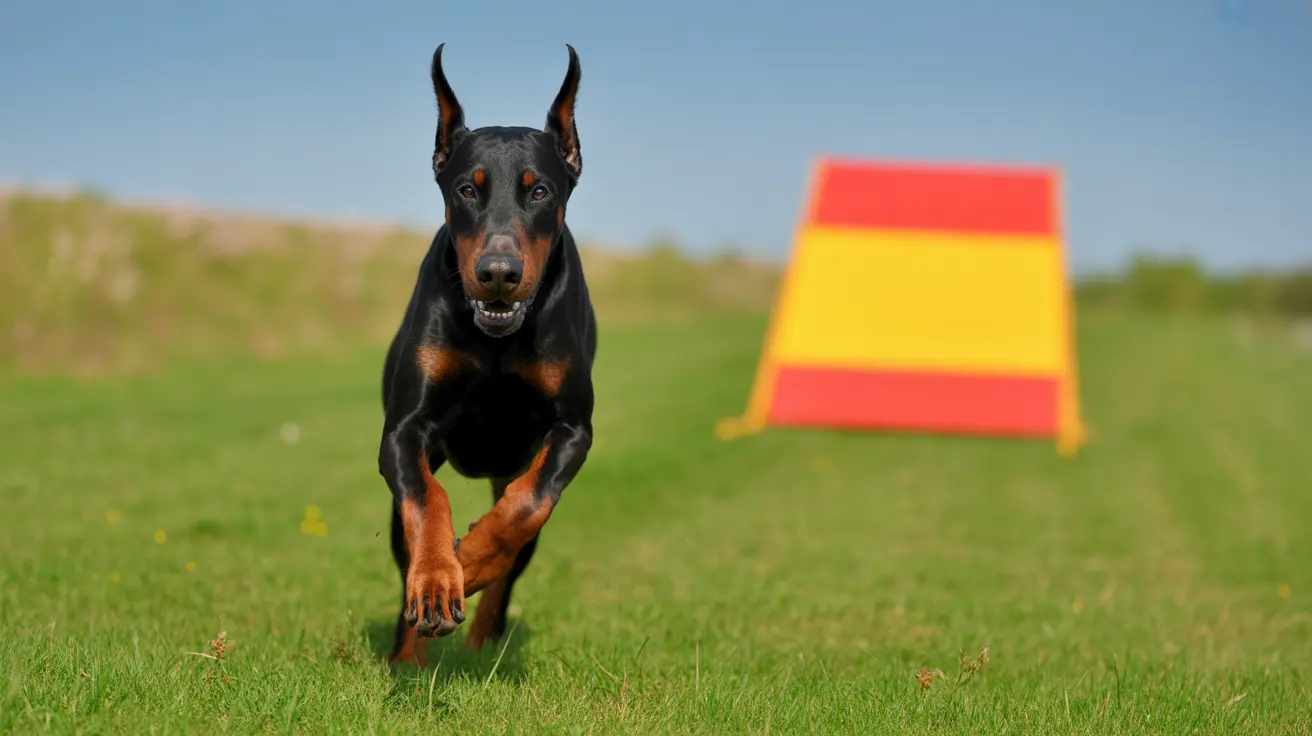Introduction
Doberman Pinschers are celebrated for their remarkable athletic abilities, with their running speed being particularly impressive. These powerful dogs combine muscular strength, aerodynamic build, and natural agility to achieve speeds that place them among the world's fastest canine breeds. Understanding their speed capabilities helps explain why they excel in various roles, from protection work to competitive sports.
With verified speeds reaching up to 35 mph in formal competitions and reported bursts exceeding 40 mph in informal settings, Dobermans demonstrate why they're considered elite canine athletes. Let's explore the fascinating details about these dogs' running abilities and what makes them such exceptional sprinters.
Top Speed and Racing Performance
In official AKC FastCAT competitions, the highest recorded Doberman speed is 34.89 mph, set by Thor Exceptional Mastercopy. However, the average competitive racing speed for Dobermans typically falls between 24-30 mph, with AKC data showing a precise average of 24.19 mph across numerous trials.
While some owners report their Dobermans reaching speeds over 40 mph during intense play or pursuit, these informal measurements should be considered alongside verified competition data. Even at their documented speeds, Dobermans can easily outpace the fastest human athletes, including Olympic sprinter Usain Bolt's top speed of 27.8 mph.
Physical Attributes Contributing to Speed
Dobermans possess several physical characteristics that enable their impressive speed:
- Long, muscular legs for maximizing stride length
- Lean, streamlined body reducing air resistance
- Deep chest cavity supporting enhanced lung capacity
- Strong cardiovascular system for sustained performance
- Large, well-developed paws providing crucial traction
These features, combined with their Greyhound ancestry, create the perfect blueprint for a fast, athletic dog. Their genetic makeup, carefully crafted through selective breeding, results in a unique combination of speed and stamina.
Factors Affecting Running Speed
Several variables influence a Doberman's running speed:
- Age and physical development
- Training and conditioning level
- Overall health status
- Environmental conditions
- Surface type and terrain
- Motivation and prey drive
Peak performance typically occurs in healthy adult dogs between 2-7 years old who receive regular exercise and proper conditioning. Environmental factors like temperature, humidity, and running surface can significantly impact their speed potential.
Training and Exercise Considerations
To help a Doberman reach and maintain optimal running speed, consider these guidelines:
- Start training gradually, especially with puppies
- Include regular cardiovascular exercise
- Incorporate sprint training and agility work
- Ensure proper warm-up before intense activity
- Monitor for signs of fatigue or overexertion
- Provide adequate rest and recovery time
Working with a veterinarian to develop an appropriate exercise program helps ensure safe and effective speed development while preventing injury.
Frequently Asked Questions
How fast can a typical Doberman Pinscher sprint and what affects their top speed?
A typical healthy adult Doberman can sprint between 25-35 mph, with verified competition speeds reaching 34.89 mph. Top speed is affected by age, health, conditioning, and environmental factors like terrain and weather conditions.
What physical traits make Dobermans one of the fastest medium-large dog breeds?
Their long legs, lean muscular build, deep chest, and strong cardiovascular system contribute to their speed. Additionally, their Greyhound ancestry provides genetic advantages for sprinting ability.
How does training and conditioning influence a Doberman's running speed and endurance?
Regular exercise, proper conditioning, and specific speed training can significantly improve a Doberman's running performance. Well-conditioned dogs typically achieve higher speeds and maintain them for longer periods.
Can Dobermans really outrun humans, including Olympic sprinters like Usain Bolt?
Yes, even the world's fastest human sprinter (Usain Bolt at 27.8 mph) would be outpaced by a fit Doberman, which can reach speeds of 34.89 mph in verified competitions.
What are safe exercise and stamina-building tips for Dobermans, especially puppies?
Start with gradual exercise introduction, avoid overexertion in puppies, ensure proper warm-up, and provide regular rest periods. Consult with veterinarians for age-appropriate exercise plans and monitor for signs of fatigue.
Conclusion
Doberman Pinschers truly stand out as exceptional athletes in the canine world, with documented speeds that place them among the fastest dog breeds. Their combination of physical attributes, genetic heritage, and trainability makes them naturally gifted runners. Whether participating in competitive events or simply enjoying recreational exercise, these remarkable dogs continue to impress with their speed and athletic capabilities.






